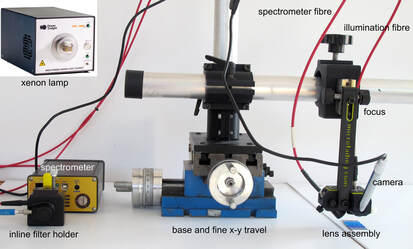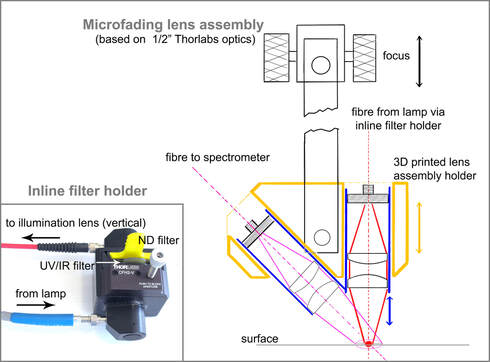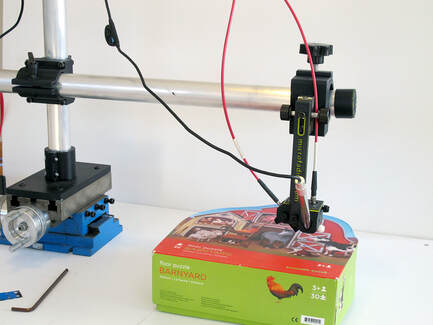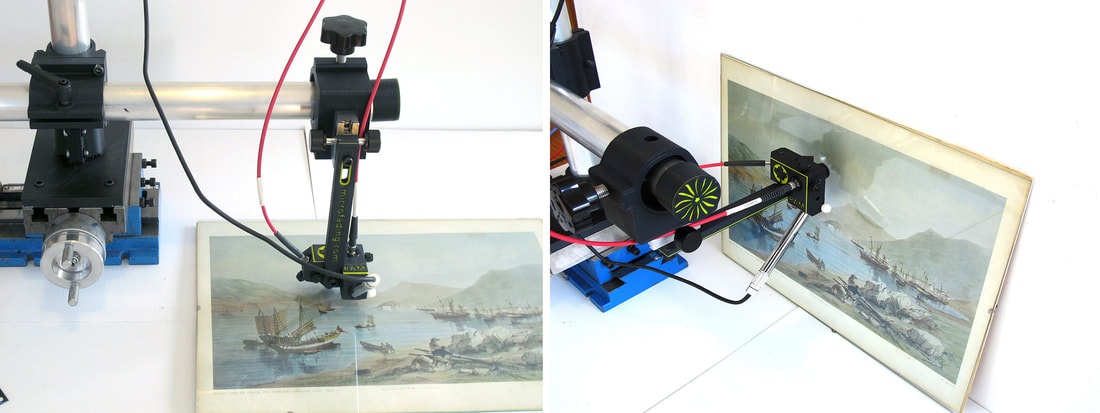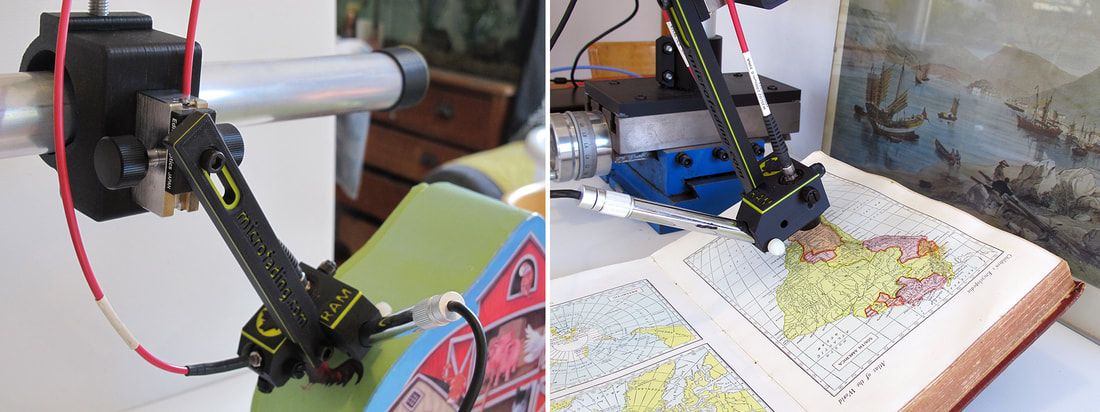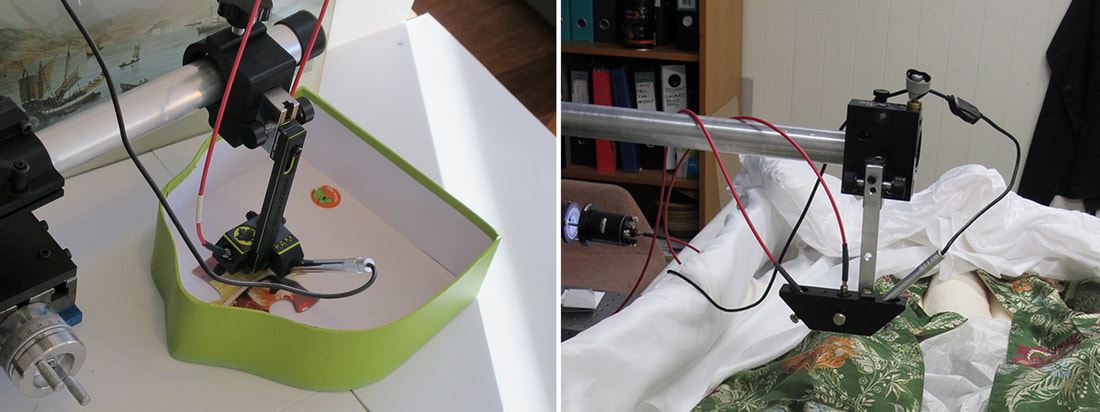|
INTRODUCTION
I can help institutions assemble a modular fibre-optic microfade tester based on Whitmore's original optical design which is robust, reliable and simple to use. The advantages of a fibre optic based instrument (and xenon illuminant) are outlined below. I am very happy to provide up to date parts lists for anyone wishing to build their own from scratch and/or existing users who wish to update their Whitmore microfde tester (MFT). Apart from some 3D printed parts, which are essential components (but in terms of cost relatively trivial) I do not sell equipment or receive commissions. I charge only for materials and my time, of which the major part is for remote or onsite installation and training (below). The aim is to allow clients to immediately apply the method, fully aware of the particulars and limitations of accelerated fade testing and its application to collection management. Video and written instructions covering installation, setup and operation of the software and hardware are provided. I purchase, assemble, pre-test and ship all of the (mostly Thorlabs) optical components. The only parts clients purchase directly are the costly spectrometer (Perkin Elmer) and xenon lamp (Ocean Optics) which, depending on the country, are sourced through their official local suppliers or directly from the manufacturers. Their warranties remain with the client. It is also usually cheaper to buy the heavy (10kg) cross-slide engineering base and x-y translation stage online locally but that can be shipped if required. With the exception of the lamp and spectrometer, there are no non user-serviceable components like auto-focus or electronics requiring return to base servicing should they fail. If the lamp or spectrometer were to fail, the replacement or repaired unit can be simply reconnected without the tricky optical alignment steps that were a feature of earlier xenon lamps and optics for microfading. I can also provide a fully set-up laptop as part of the package, avoiding IT involvement in installing the software and VBA macros used to acquire the spectral data and create the tables and charts for the report templates. It is sometimes easier for conservation departments to include the cost of the laptop in their funding bid, and a pre-configured computer makes the installation and training easier because everything is tested before delivery. |
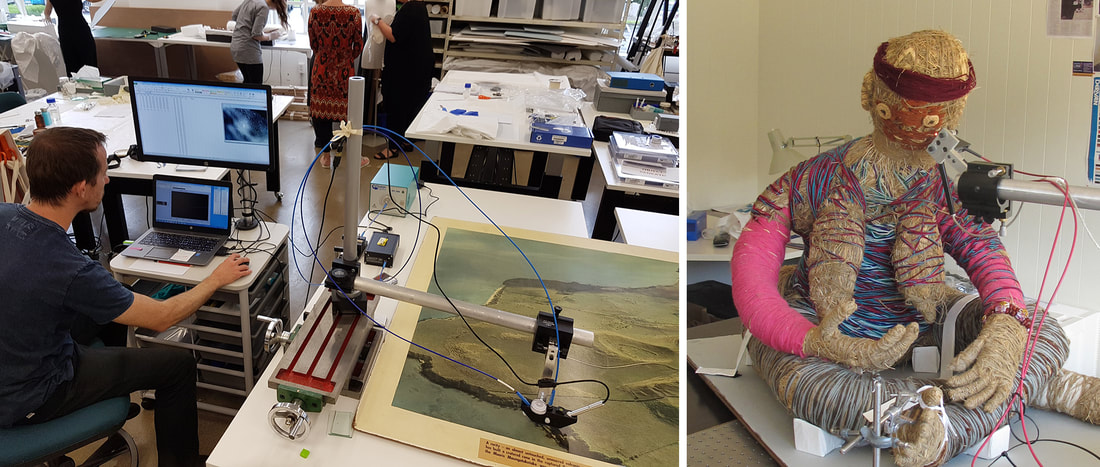
600mm reach standard, can be extended to any length with a bridging 1.5" (38mm) aluminium tube supported at the other end. Left hand side, aerial survey photograph Auckland War Memorial Museum NZ. Right hand side, Australian Central Desert Aboriginal life-size Tjanpi figure, National Museum of Australia
HARDWARE
SOFTWARE (free)
SETUP AND TRAINING
The remote or onsite setup and training brings users up to speed with all aspects of microfade testing and its application to the display of light-sensitive objects. It avoids the initial learning curve, peer consultation and literature surveys associated with the introduction of any new and unfamiliar technique. Like other analytical methods applied to real materials and objects (e.g. handheld XRF) there are tricks of the trade, interpretive traps, and misconceptions that are not immediately obvious. I have more than 15 years routine testing, method development and research using the technique, and a very large body of object tests to draw upon. My bread and butter is still contract fade testing for cultural institutions. Setup and training includes:
SUPPORT
COST (±15% depending on freight, agents commissions, taxes)
- Ocean Insight HPX-2000-HP-DUV xenon lamp. Filtered 400-700nm using a single single "hot mirror' visible bandpass filter.
- Perkin Elmer PDA512 (formerly Control Development) spectrometer with order sorting filter option for FORS applications up to 1200nm (below). This is an extremely high quality, high resolution stand-alone UV-visible spectrometer which may also be used outside MFT and FORS (below) for standard colour measurement, illuminant (including LED) characterisation, light filter characterisation (for example window films), absolute irradiation measurement (W/cm^2/nm), and solution spectroscopy. Some of these uses require additional accessories such as a calibrated light sources. A solution absorption cuvette may be placed within the Thorlabs inline filter-holder provided. Specifications here.
- Thorlabs components including 0.5” lenses and lens barrels, inline filter holder, UV-resistant optical fibre, optical filters.
- Edmund Optics rack and pinion focus stage #03-682
- 3D printed opto-mechanical components including lens assembly head (MFT head).
- Engineering cross-slide table for fine X_Y translation and stable base.
- Microscope camera for fine location control and documentation.
SOFTWARE (free)
- Perkin Elmer (Control Development) Spec32, including datalogging and live DeltaE tracking.
- My Excel VBA routines for Spec32 data acquisition, table and chart presentation and reporting.
- Getty Conservation Institute (GCI) Spectra Viewer software developed for this particular spectrometer and its Spec32 software. This is an excellent alternative to my XL macros, although it does not offer some of the chart and table options for reporting.
- Report templates (PowerPoint). Some examples of reports based on tables and charts from the XL macros here.
SETUP AND TRAINING
The remote or onsite setup and training brings users up to speed with all aspects of microfade testing and its application to the display of light-sensitive objects. It avoids the initial learning curve, peer consultation and literature surveys associated with the introduction of any new and unfamiliar technique. Like other analytical methods applied to real materials and objects (e.g. handheld XRF) there are tricks of the trade, interpretive traps, and misconceptions that are not immediately obvious. I have more than 15 years routine testing, method development and research using the technique, and a very large body of object tests to draw upon. My bread and butter is still contract fade testing for cultural institutions. Setup and training includes:
- Installation and use of apparatus and software..
- Data acquisition and reporting workflow. This is designed to be as rapid and efficient as possible to maximise its use as a routine screening tool.
- Relevant optics.
- Spectroscopy.
- Accelerated studies.
- Photochemistry.
- Interpretation of MFT data: approximations, reciprocity, errors.
- Light exposure guidelines based on MFT data and integration into museum policies and procedures.
SUPPORT
- Unlimited ongoing personal support (within reason).
- Large established user base for the same or similar equipment (I can put you in touch).
- Access to reference spectra, literature collection, and a very large collection of test data and reports on most conceivable light-sensitive objects.
COST (±15% depending on freight, agents commissions, taxes)
- Basic hardware cost: US$16500 ($17450 with spectrometer order sorting filter option for extended wavelength FORS up to about 1100nm.
- Setup and training: US$3000-5000 depending on requirements and experience.
- Fully set up and tested laptop option, approximately US$1200.
- Running costs: the 1000 hour rated xenon bulb replacements cost approximately US$3500. The bulbs probably last much longer because the lamp initially has far more intensity than required for our application.
|
ADVANTAGE OF FIBRE OPTIC DESIGN
In MFT Illumination must be normal to the surface under test. With the fibre optic design the microfading "head" can be rapidly positioned out to 600mm along the boom arm (as supplied) and at any angle whilst still allowing accurate focusing. Testing of large and 3D objects is, therefore, a very simple process without the need to arrange for the object (or parts of it) to be positioned at the correct angle under a microfading head with limited flexibility of movement and orientation. It is useful for books, for example, because it avoids ether forcing the spine to flatten it or spending time propping it up into a stable and suitable orientation. The boom arm can be extended to any length (to bridge large paintings for example) with 1.5" (38mm) aluminium tube and support for the other end.. This can be as simple as a laboratory stand and clamp. The equipment as standard comes with 2m illumination and spectrometer fibres and while these are adequate for most situations, they may be substituted with longer ones if necessary. ADVANTAGES OF XENON In practice both LED and xenon are fine for routine lightfastness sorting. Whilst an LED illuminant would appear to be a better choice for museums who have largely switched to LEDs, in practice the major potential predictive errors of MFT (and all other accelerated ageing techniques) are the unknown and in practice unknowable reciprocity deviations likely to dwarf the relatively minor spectral power distribution differences. If anything, filtered xenon tends to provide an inbuilt safety factor by exaggerating the light-sensitivity of colourants lit by LEDs and it closely approximates the spectral power distribution (SPD) of UV-filtered sunlight through glass, a common illuminant in museums (especially in lobbies) which an LED source cannot replicate. It also more closely approximates the SPD for which the ISO Blue Wool internal calibration standards were designed. Xenon's other advantages include:
|
|
Last updated: July 2023
